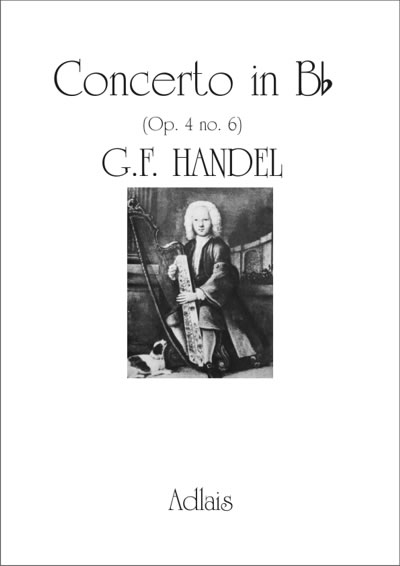 |
|||
| |
of Harp Music |
| © 2004-2025 ADLAIS |
| Concerto
in Bb
(Op. 4 no. 6) 1st Movement GF Handel (1685-1759) arr. for Celtic Harp by Ann Griffiths |
return to previous page |
 |
Work: | Part work arranged for Lever Harp |
| Catalogue No: | Adlais 110 | |
| ISMN: | 979-0-57032-055-4 | |
| Edition: | 2004, A4 stapled | |
| Suitable for: | Grade 8 Lever Harp | |
| Price:: | £5.00 Go to shop | |
| Examination: | LCM Grade 8 List B (2014-2016) | |
HANDEL'S HARP CONCERTO The first performance of Handel's Harp Concerto is well documented. It occurred on 17 February 1736, when it was played as an Entr'acte in a performance of his Oratorio Alexander's Feast. The harp soloist is thought to have been one William Powel, a Welshman then active in London, who played it on the triple harp. The poem by Dryden which Handel set as Alexander's Feast dramatises the legend that Alexander - son of Philip of Macedon, conqueror of Darius, King of Persia, and lover of the courtesan Thaïs - was influenced by the musician Timotheus to burn the city of Persepolis, in which he was feasting. After the Overture, the tenor soloist describes the scene at a celebration banquet following Alexander the Great's conquest of Persia. Alexander sits in state with Thaïs, and the entertainment at the feast is provided by Timotheus, who accompanies his songs on the lyre. Handel's harp is meant to present Timotheus, who 'With trembling fingers touch'd the lyre/ And heavn'ly joys inspired'. Three performances of Alexander's Feast were given in 1736 and 1737 - the last time it can be certain that the Harp Concerto was included in a performance under Handel's direction. Three performances were also given in 1739, one of them being for the benefit of the 'Fund for Decay'd Musicians'. This Benefit performance included 'a new Concerto on the Organ by Mr Handel, on purpose for this occasion', and this almost certainly replaced the original Harp Concerto. In 1742 the concertos noted in the earlier librettos of the performances were removed, never to return. Handel's links with the harp were always strong. From the beginning, when he was a young boy in Halle, Zachow, his teacher, set him to copying scores of some of the cantatas he had composed. One of the earliest that Handel copied at the age of about eight, was one which contained a very important part for the triple harp. It is thought that the portrait of the be-wigged small boy, pictured with his harp and his pet dog (frontispiece), may well be a portrait of Handel painted at about this time. This new edition of the first movement of Handel's Harp Concerto (Op.4 no.6) has been arranged so that it can be played as a solo on the Celtic harp. Justification for such a solo arrangement may be derived from the fact that in the mid-1740s, the blind Welsh harpist John Parry played the Concerto as a 'Lesson without accompaniments', that is to say, as a harp solo, and that this version had Handel's total and unqualified approval. The new version for Celtic harp also has the advantage that it can be used as the solo part when the work is performed with orchestra. © Ann Griffiths 2004 |

